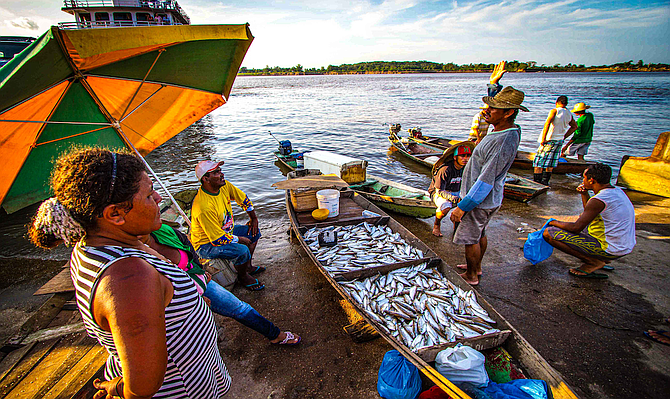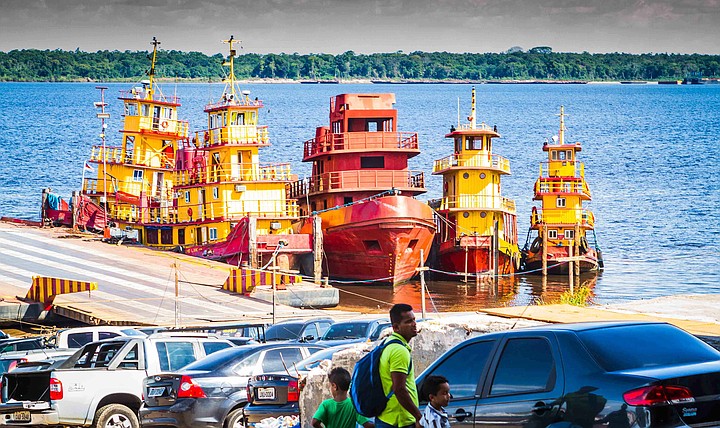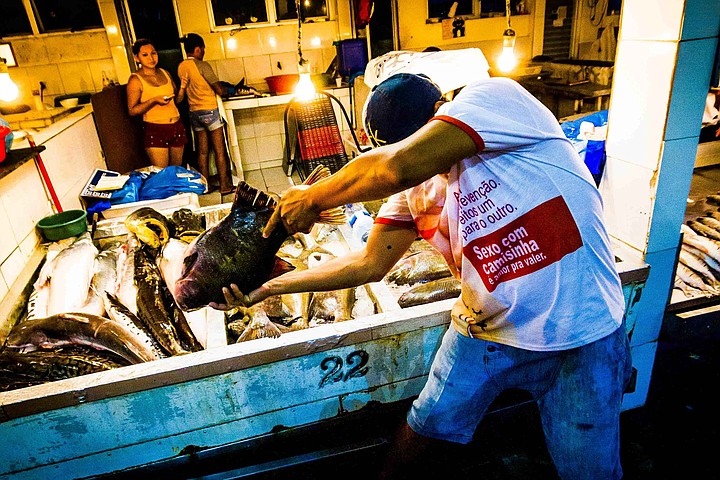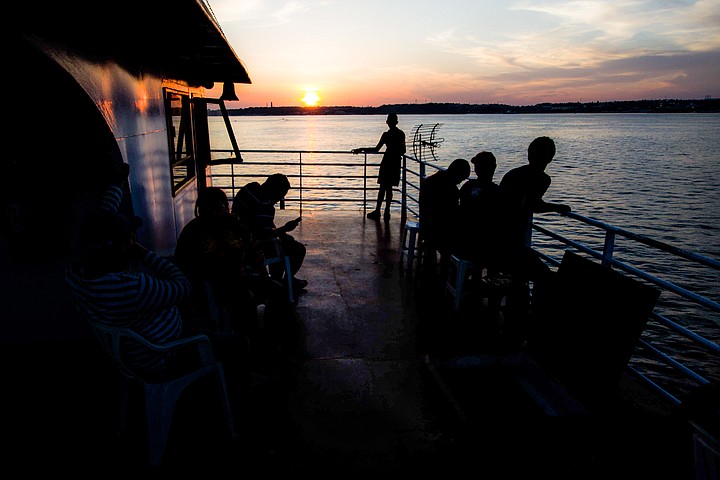 Facebook
Facebook
 X
X
 Instagram
Instagram
 TikTok
TikTok
 Youtube
Youtube

June 2020 UPDATE: The Brazilian state of Amazonas has been hit particularly hard by the COVID-19 pandemic – with the capital, Manaus, having the only intensive care beds in the state. Read more about how COVID is impacting indigenous Amazon villages.
I’m standing at a bus stop in Manaus, under a hot, bright sun, and the picture I’m painting isn’t pretty. I’m panting, and parts of me that I didn’t know could sweat are contributing little winding rivulets to the already well-established tributaries running from my forehead and armpits. The pavement’s damp, and a few ants have come to take drink.

The heat and humidity of Manaus are difficult to describe and impossible to escape, and though they may not show it as pathetically as I do, I know the locals feel it too. In the hours before dawn, grown men play in the spray of cracked water lines. By noon, the swelter is so severe, that some wear nothing at all.
The Spanish arrived here in the 15th century, initiating, in familiar colonial tradition, an extended period of unbidden governance and the perverse horrors of slavery. A few centuries later, a rubber boom turned the city into a garish hub of unbridled avarice—roughly three decades devoid of modesty or material restraint. For an example of the sort of shameless extravagance that defined the time, historian Robin Furneaux gives us this: “If one rubber baron bought a vast yacht, another would install a tame lion in his villa, and a third would water his horse on champagne.”
Classy.
Today, though, with one of Brazil’s busiest airports and a near-boundless assortment of hotels, restaurants, and tour operators, Manaus is more a great metropolis of meetings. It’s where the wider world meets Amazonia, where the big city holds a line with the rainforest. And it’s here also that the Amazon River meets the Rio Negro.
You’ve almost certainly heard of the Meeting of Waters, where, for seven stubborn kilometers in the middle of South America, the warm, dark eddies of the Negro refuse to mix with the pale, cool currents of the Amazon.

You might also have heard that this great river junction is visible from space. And it is, given the right telescope, which makes this something of a moot claim these days, given that with the right telescope, you can read a newspaper from space.
It is, nonetheless, a natural phenomenon on a massive scale.
You can take a trip to the confluence on a fast and flashy tour boat, if you like. They’ll provide guides, light snacks, government-approved safety equipment, and aggressive requests for tips. But this, like bottle service in Vegas, or yoga for dogs, might be thought a crass and costly proposition, and it might be much better—and certainly cheaper—to jump on a local ferry at nearby Porto da Ceasa. From here, unnamed ferries leave at unscheduled times to unstated destinations. None, however, charge a fee to foot passengers, and nearly all cross the Meeting of Waters.

Porto da Ceasa is a half hour ride outside of Manaus. The bus pulled up, and I stepped on, leaving the ants to quench their thirst.
There’s a lot of fish in Porto da Ceasa, and it’s a very pungent place. Just about everywhere you look there is a fish somewhere between river and dinner. Boys push piles of it about in wheelbarrows between fish stalls lining cracked, concrete ramps down to the docks. It writhes in nets and lies cold and dead on beds of ice. It boils in vats and sizzles on barbecues, the scaly ashes falling about like hot snow. It is everywhere, and the ferries, too, are full of it.

Just now one was loading up, buckets and totes and crates of fish in the backs of flatbed trucks. A hodgepodge of other vehicles packed with plants, furniture, refrigerators, spare tires, and mattresses filled the rest of the deck, a big and jumbled assortment of everyday items, made conspicuous only in transit.
The horn blew and the boat was off, bound, with a bit of luck, somewhere across the Meeting of Waters.

Wherever we were going, we cruised past men in dugout canoes casting nets near the river’s edge. On the outside deck, a couple fought passionately in the bright, equatorial heat, while men inside played cards and smoked cigars under the low glow of a tiny T.V. Occasionally, a river dolphin came up for air, a rapid blast and a flash of pink in the wavelets of the river. From a little mast at the back of the ship, the Brazilian flag flapped violently in the hot wind.
Ferries don’t, of course, stop for very much, anything really, including a good look at the Meeting of Waters, but it doesn’t take long to get the idea. The hull sliced through the churning contour like a spoon through a cocktail of Bailey’s and Kahlua.
Ferries do, however, make sure to stop at their destinations, in this case a small settlement on the river’s bank, where shirtless men drank beer at lean-tos and large ladies under parasols tended kettles of (you’ve got it) fish.

The boat took on a new payload, and set off again, bound, with a bit of luck, back across the Meeting of Waters.


June 2020 UPDATE: The Brazilian state of Amazonas has been hit particularly hard by the COVID-19 pandemic – with the capital, Manaus, having the only intensive care beds in the state. Read more about how COVID is impacting indigenous Amazon villages.
I’m standing at a bus stop in Manaus, under a hot, bright sun, and the picture I’m painting isn’t pretty. I’m panting, and parts of me that I didn’t know could sweat are contributing little winding rivulets to the already well-established tributaries running from my forehead and armpits. The pavement’s damp, and a few ants have come to take drink.

The heat and humidity of Manaus are difficult to describe and impossible to escape, and though they may not show it as pathetically as I do, I know the locals feel it too. In the hours before dawn, grown men play in the spray of cracked water lines. By noon, the swelter is so severe, that some wear nothing at all.
The Spanish arrived here in the 15th century, initiating, in familiar colonial tradition, an extended period of unbidden governance and the perverse horrors of slavery. A few centuries later, a rubber boom turned the city into a garish hub of unbridled avarice—roughly three decades devoid of modesty or material restraint. For an example of the sort of shameless extravagance that defined the time, historian Robin Furneaux gives us this: “If one rubber baron bought a vast yacht, another would install a tame lion in his villa, and a third would water his horse on champagne.”
Classy.
Today, though, with one of Brazil’s busiest airports and a near-boundless assortment of hotels, restaurants, and tour operators, Manaus is more a great metropolis of meetings. It’s where the wider world meets Amazonia, where the big city holds a line with the rainforest. And it’s here also that the Amazon River meets the Rio Negro.
You’ve almost certainly heard of the Meeting of Waters, where, for seven stubborn kilometers in the middle of South America, the warm, dark eddies of the Negro refuse to mix with the pale, cool currents of the Amazon.

You might also have heard that this great river junction is visible from space. And it is, given the right telescope, which makes this something of a moot claim these days, given that with the right telescope, you can read a newspaper from space.
It is, nonetheless, a natural phenomenon on a massive scale.
You can take a trip to the confluence on a fast and flashy tour boat, if you like. They’ll provide guides, light snacks, government-approved safety equipment, and aggressive requests for tips. But this, like bottle service in Vegas, or yoga for dogs, might be thought a crass and costly proposition, and it might be much better—and certainly cheaper—to jump on a local ferry at nearby Porto da Ceasa. From here, unnamed ferries leave at unscheduled times to unstated destinations. None, however, charge a fee to foot passengers, and nearly all cross the Meeting of Waters.

Porto da Ceasa is a half hour ride outside of Manaus. The bus pulled up, and I stepped on, leaving the ants to quench their thirst.
There’s a lot of fish in Porto da Ceasa, and it’s a very pungent place. Just about everywhere you look there is a fish somewhere between river and dinner. Boys push piles of it about in wheelbarrows between fish stalls lining cracked, concrete ramps down to the docks. It writhes in nets and lies cold and dead on beds of ice. It boils in vats and sizzles on barbecues, the scaly ashes falling about like hot snow. It is everywhere, and the ferries, too, are full of it.

Just now one was loading up, buckets and totes and crates of fish in the backs of flatbed trucks. A hodgepodge of other vehicles packed with plants, furniture, refrigerators, spare tires, and mattresses filled the rest of the deck, a big and jumbled assortment of everyday items, made conspicuous only in transit.
The horn blew and the boat was off, bound, with a bit of luck, somewhere across the Meeting of Waters.

Wherever we were going, we cruised past men in dugout canoes casting nets near the river’s edge. On the outside deck, a couple fought passionately in the bright, equatorial heat, while men inside played cards and smoked cigars under the low glow of a tiny T.V. Occasionally, a river dolphin came up for air, a rapid blast and a flash of pink in the wavelets of the river. From a little mast at the back of the ship, the Brazilian flag flapped violently in the hot wind.
Ferries don’t, of course, stop for very much, anything really, including a good look at the Meeting of Waters, but it doesn’t take long to get the idea. The hull sliced through the churning contour like a spoon through a cocktail of Bailey’s and Kahlua.
Ferries do, however, make sure to stop at their destinations, in this case a small settlement on the river’s bank, where shirtless men drank beer at lean-tos and large ladies under parasols tended kettles of (you’ve got it) fish.

The boat took on a new payload, and set off again, bound, with a bit of luck, back across the Meeting of Waters.
Comments